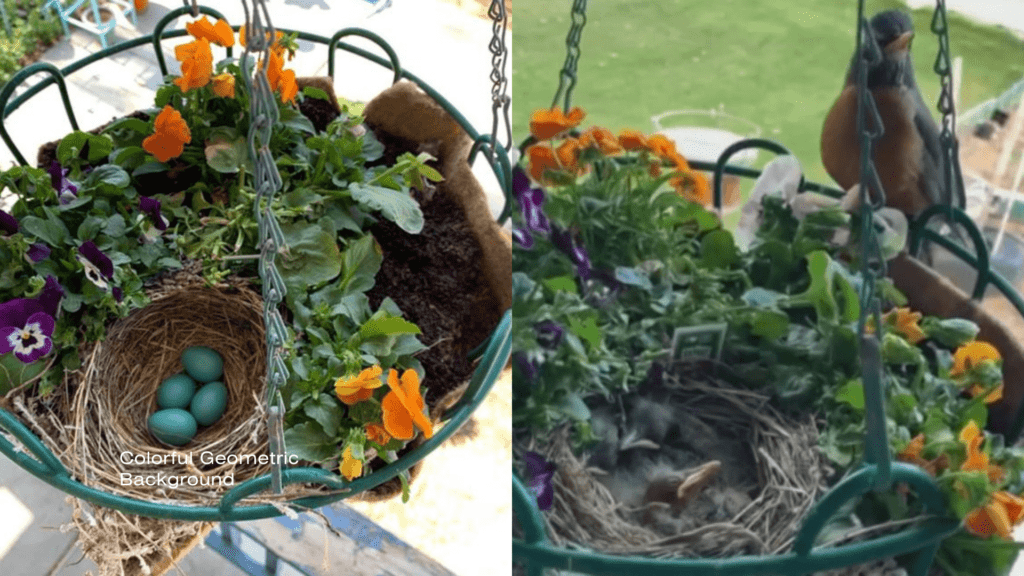If you find a bird’s nest with eggs in your hanging plant, don’t panic! It’s actually not that uncommon for birds to build nests in hanging plants.
The most important thing to do is to leave the nest undisturbed. The mother bird will take care of her eggs and eventually the baby birds will fly away.
How to Spot a Bird’s Nest

If you have a bird’s nest in your hanging plant, there are a few things you can look for to be sure.
Check for eggs. If there are eggs in the nest, then it is definitely a bird’s nest.
Look at the size of the nest. Bird’s nests are usually quite small, so if the nest is large, it is probably not a bird’s nest.
Look at the material the nest is made out of. Bird’s nests are typically made out of twigs or other natural materials. If the nest is made out of man-made materials, it is probably not a bird’s nest.
Benefits of Having a Bird’s Nest in Your Hanging Plant
There are many benefits to having a bird’s nest in your hanging plant. For one, it provides shelter and protection for the birds.
The nest also helps to keep the plants healthy by providing them with nitrogen-rich droppings. In addition, the presence of the nest can deter pests from attacking the plants.
Types of Nests and Eggs Found in Hanging Plants
There are many different types of birds that build nests in hanging plants, and each type of bird has a different type of nest and eggs. Some common types of birds that build nests in hanging plants include:
- House finches: These birds typically build their nests in small, shallow cups made from twigs, grass, and other plant material. The eggs are small and pale blue in color.
- Goldfinches: Goldfinches often build their nests in thistles or other prickly plants. Their nests are usually well-hidden and difficult to spot. The eggs are small and yellowish in color.
- Hummingbirds: Hummingbirds typically build their nests using spider webs or plant down. The nests are often cup-shaped and very delicate. The eggs are extremely small (about the size of a pencil eraser) and white in color.
Preparing the Environment for a Bird’s Nest and Eggs
When you have decided to allow a bird to nest in your hanging plant, there are a few things you can do to prepare the environment for the eggs and nest.
Make sure the plant is strong enough to support the weight of the nest and eggs. You may need to add some additional support if necessary.
Ensure that the leaves of the plant are not poisonous or harmful in any way to the bird or its chicks. If you are not sure, consult with a local expert or nursery.
Trim back any branches or leaves that might obstruct the entrance to the nest or block the view of potential predators.
By taking these simple steps, you can create a safe and supportive home for your new feathered friends.
Preventing Unwanted Birds from Building Nests
If you have a problem with birds building nests in your hanging plants, there are a few things you can do to prevent it. Try hanging the plants from a wire or mesh cage.
You can also cover the plant with netting or cheesecloth. Make sure the openings are small enough so that the birds can’t get through.
You can try spraying the plants with a mixture of water and vinegar.
Tips on Caring for the Nest and Eggs
As the weather gets warmer, you may find a birds nest with eggs in your hanging plant. Here are some tips on caring for the nest and eggs:
- Leave the nest alone if you can. The parents will take care of the eggs and young birds.
- If you need to move the nest, do so gently and carefully. Put it in a safe place away from predators and harsh weather conditions.
- Provide extra food and water for the parents if you can. This will help them care for their young.
- Monitor the nest regularly to make sure everything is okay. But don’t disturb the birds too much, as this can stress them out and cause them to abandon the nest.
Conclusion
Finding a bird’s nest with eggs in your hanging plant is an exciting event. While it may be tempting to remove the nest and take the eggs home, you should always leave them where they are so that the birds can enjoy their little family-building adventure without any human interference.
Remember that being a good steward of nature means respecting all living creatures, no matter how small or seemingly insignificant they might appear.
